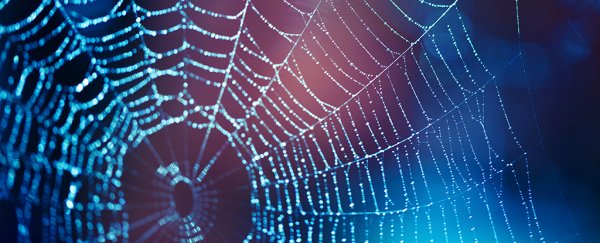Get right up close to a spider web, and you'll see some very particular properties: it stays taut in the wind, is really hard to break apart, and any flies coming into contact with it are trapped, rather than bouncing off it.
Well, the same sticky substance that traps the flies also helps maintain tension in the web, and now scientists have come up with a way of replicating this in the lab – with a 'liquid wire' that exhibits many of the same properties of webs spun by spiders.
So why doesn't a spider web sag in the wind? It's because the gossamer fibres that it's composed of are coated in a watery glue, which takes up any slack as the threads are stretched (as well as trapping flies). It's this feat of engineering that the scientists from the University of Oxford in the UK and the Université Pierre et Marie Curie in France have managed to mimic in their own composite fibres.
The synthetic wires share the same characteristics as a spider web in that they can extend like a solid and compress like a liquid, and the team behind them used oil droplets on a plastic filament to achieve the effect. According to the researchers, getting the right balance between fibre elasticity and droplet surface tension was the key.
You can see the liquid wire material in action in the video below:
"Spider silk has been known to be an extraordinary material for around 40 years, but it continues to amaze us," said one of the team, Hervé Elettro from the Université Pierre et Marie Curie. "While the web is simply a high-tech trap from the spider's point of view, its properties have a huge amount to offer the worlds of materials, engineering, and medicine."
"The thousands of tiny droplets of glue that cover the capture spiral of the spider's orb web do much more than make the silk sticky and catch the fly," added fellow researcher Fritz Vollrath from Oxford. "Surprisingly, each drop packs enough punch in its watery skins to reel in loose bits of thread. And this winching behaviour is used to excellent effect to keep the threads tight at all times, as we can all observe and test in the webs in our gardens."
And it's not just for show. The team says that this new liquid wire technology could help in the microfabrication of complex structures, such as the construction of miniature motors and the creation of stretchable, hybrid solid-liquid materials for all kinds of purposes in biotechnology.
Awesome news, and it wouldn't even hurt a fly.
The research has been published in PNAS.
